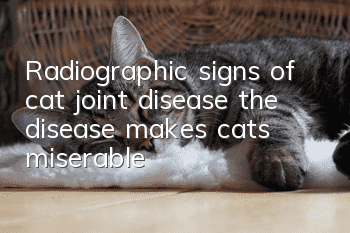Radiographic signs of cat joint disease, the disease makes cats miserable!

Joint problems require X-ray examination
X-ray examination signs of joint diseases in cats. Diseases make cats miserable! Joint diseases in cats will slowly break out as they age. The causes are divided into congenital and acquired causes. Specific diagnosis also requires the use of some auxiliary means such as X-ray examination. In the X-ray examination of joint diseases, different symptoms have different appearances, which require us to identify them.
1. Changes in the articular surface
The articular surface is not smooth, the articular cartilage and the underlying bony articular surface bone are eroded and replaced by pathological tissue. As a result, the joints are damaged and the joint surfaces are not smooth. In the early stage of the disease, when only articular cartilage is destroyed, the joint space becomes narrowed, and the bony articular surface is damaged and appears nibbled, rough, or with obvious defects. It is more common in the late stages of septic joint inflammation, degenerative joint disease, etc.
The articular margin ossifies and new bone proliferates around the articular surface, forming an articular lip or articular osteophyte. It is more common in degenerative osteoarthropathy and ossification of tendons and ligaments. A round or round-like defect area shadow appears in the articular subchondral bone in the joint bone cyst cavity. The shadow has clear edges and may or may not communicate with the joint cavity. This is called a bone cyst.
The joint surface is broken, cracks appear on the joint surface or there is a large defect in the joint bone. Seen in intra-articular fractures or bone end fractures.
2. Changes in the joint space
The widening of the joint space. Due to inflammation, a large amount of joint effusion can be seen. The joint capsule can be bulging and the joint space can be widened. This Such lesions are more common in various effusion arthritis and arthropathy.
Joint space narrowing: When joints undergo degenerative changes, articular cartilage degeneration, necrosis, and dissolution lead to joint space narrowing, which is more common in the later stages of septic arthritis, degenerative joint disease, etc.
The width of the joint space is uneven. When the supporting ligaments of the joint, such as the collateral ligaments, are broken, the joint loses stability. At this time, the joint will show an X-ray image with one side wider and one side narrower.
The disappearance of the joint space is mostly an X-ray manifestation of bony connection of the joint, that is, bony ankylosis of the joint. When the joint is obviously destroyed, the bone ends of the joint are connected by bone tissue, resulting in bony healing. It is more common in post-healing acute septic arthritis and degenerative joint diseases.
The result of an intra-articular fracture caused by a foreign body in the joint space is that the fracture fragments are free in the joint cavity and a high-density bone image appears; foreign foreign bodies can enter the joint cavity during joint trauma, and the shadow of the foreign body can be seen; joint infection produces gas After the bacteria, an air shadow appears in the joint space.
3. Changes in shadows of extra-articular soft tissues
The main cause of swelling is inflammation of the joints. Due to joint effusion or congestion, hemorrhage, edema and inflammatory exudation of the joint capsule and its surrounding soft tissues, the soft tissues around the joints are swollen. X-ray films show increased shadows, increased density and unclear tissue structure of the extra-articular soft tissues.
Atrophy, atrophy of extra-articular soft tissue can causeThe shadow of extra-articular soft tissue on X-rays shrinks and the density decreases. Such lesions are common in joint disuse, such as long-term fracture fixation.
An open injury occurs when a foreign body in the soft tissue joint occurs, the foreign body enters the soft tissue, and an air shadow or shadow of the foreign body appears in the shadow of the soft tissue outside the joint. Avulsion fractures of joint capsules or joint ligaments and ossification of muscles, tendons, ligaments or joint capsules at the joint bone insertion points will cause high-density bony shadows to appear in the extra-articular soft tissue shadows.
- Cats tremble while sleeping
- The cat's tail does not move, but the tip of the tail moves
- How to teach a cat to be alone when the owner is not at home? Cat training!
- Is cat urine poisonous?
- How to train your cat to become a social master? Cultivate social behavior in kittens!
- Things to note when training kittens, cat lovers, come and take a look!
- Are teacup cats easy to raise? Is there a breed of teacup cat?
- 6 ways to train a kitten
- Male cat suddenly becomes aggressive and bites and scratches people
- What are the pros and cons of the Siberian Forest Cat?



